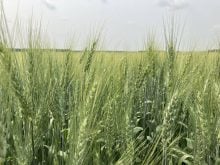Alberta
South
Disease threat
Crops remain two to three weeks behind normal development despite a recent spell of warmer weather. Cereal leaf diseases are becoming a concern. Populations of cabbage seedpod weevils are high in the region and may pose a threat.
Central
Spraying complete
The cutworm threat is diminishing because many fields have been sprayed and larger canola plants can withstand the pressure. Net blotch complex is reported in cereal crops.
Read Also

Why feds imposed EV tariffs
Moe and Kinew have a fight on their hands when it comes to eliminating the EV tariff. Canada has to worry about pissing off the U.S. and Mexico and hundreds of thousands of auto workers.
Northwest
Rain welcome
Isolated showers helped alleviate dry conditions in some areas. Lack of rain over last month has reduced disease pressure and allowed producers to cut back on herbicide and fungicide applications. Cutworms caused significant damage in canola fields, forcing some producers to re-seed crops. Reseeded acres have struggled in dry conditions and are only in the four leaf stage, compared to spring-seeded crops that are now flowering.
Northeast
Hay harvest difficult
Most crops are about 10 days behind normal but cereals and canola crops look healthy. Humid weather is forcing farmers to consider spraying. Harvesting hay has been difficult with wet conditions.
Peace and B.C.
Moisture essential
Scattered showers were reported. Some canola fields are now irreversibly damaged because of dry soil conditions. Other crops are hanging in there but rain is needed. About 20 to 50 percent of canola is blooming but some fields are struggling to flower because of lygus bug pressure.
Manitoba
Southwest
Disease pressure
Crops are recovering from moisture stress. Warm weather is aiding sunflowers and corn. Flax is starting to flower. Disease pressure for all crops is rated at moderate to heavy, with heavy pressure on winter wheat.
Central
Root rot evident
Water is still visible in fields around Morden and Morris, but crops in other parts of the region have responded to early July’s warm temperatures. Soybeans are still struggling in the soaked soil and iron chlorosis has caused yellowing of the crop. Root rot is also showing up in soybeans, canola and cereal crops.
Eastern
Good hay conditions
Yield potential has improved thanks to warm temperatures and almost no precipitation in early July. Spring wheat and oats are 70 to 100 percent headed out. Early seeded canola is done blooming. Hay conditions are good with alfalfa-grass stands producing about two tons per acre.
Interlake
Spraying complete
Pastures are poor because lowland pasture is soaked and higher areas have been overgrazed. Some producers are considering fencing off hay land for pasture. Fungicide application is mostly completed on crops that are worth the investment. Insurance adjusters are busy determining yield potential on flooded crops that producers would like to work down.
Northwest
Some land reseeded
Much of the cereals are in the flag leaf stage to flowering. The hemp crop struggled to emerge in wet conditions this spring and crop condition varies. Some greenfeed acres have been seeded. Many acres of tame and native hay remain wet.
Saskatchewan
Southwest
Heat drying land
Storms and showers brought 12 to 40 mm of precipitation. Cropland topsoil moisture is now rated as 21 percent surplus and 77 percent adequate. Heat is helping crops recover from excess moisture this spring. The hay crop is drying slowly because of high humidity, showers and heavy swaths.
Southeast
Crops stressed
Diamondback moths are present but haven’t reached economic thresholds for spraying. Crops are still showing stress from excess moisture and stressed canola crops are short and flowering. Fields that missed last week’s rains are improving.
West-Central
Fields soggy
Nearly 25 mm of rain fell, with 65 mm around the Battlefords. Some fields are now saturated and others have become impassable. About 46 percent of cereals are tillering, 33 percent are jointed and 17 percent are at the flag leaf stage.
Approximately eight percent of the hay crop is cut and quality is good to excellent.
East-Central
Surplus moisture
More precipitation fell for already soaked crops, as Yorkton received another 67 mm of rain. About 140 mm fell near Rama and 75 mm around Elross. Approximately 68 percent of cropland topsoil is rated at surplus moisture. Lentil and flax crops are suffering the most. About 30 percent of canola crop is flowering.
Northwest
Excellent hay
About 26 percent of canola is flowering and 71 percent of cereals are jointed or in the flag leaf stage. Haying has just started and quality is good to excellent. Some farmers are seeding greenfeed..
Northeast
Yellowing fields
After more rains last week, cropland topsoil is now rated at 90 percent surplus moisture. Crop conditions are variable. Many fields are patchy and turning yellow due to soggy conditions.














